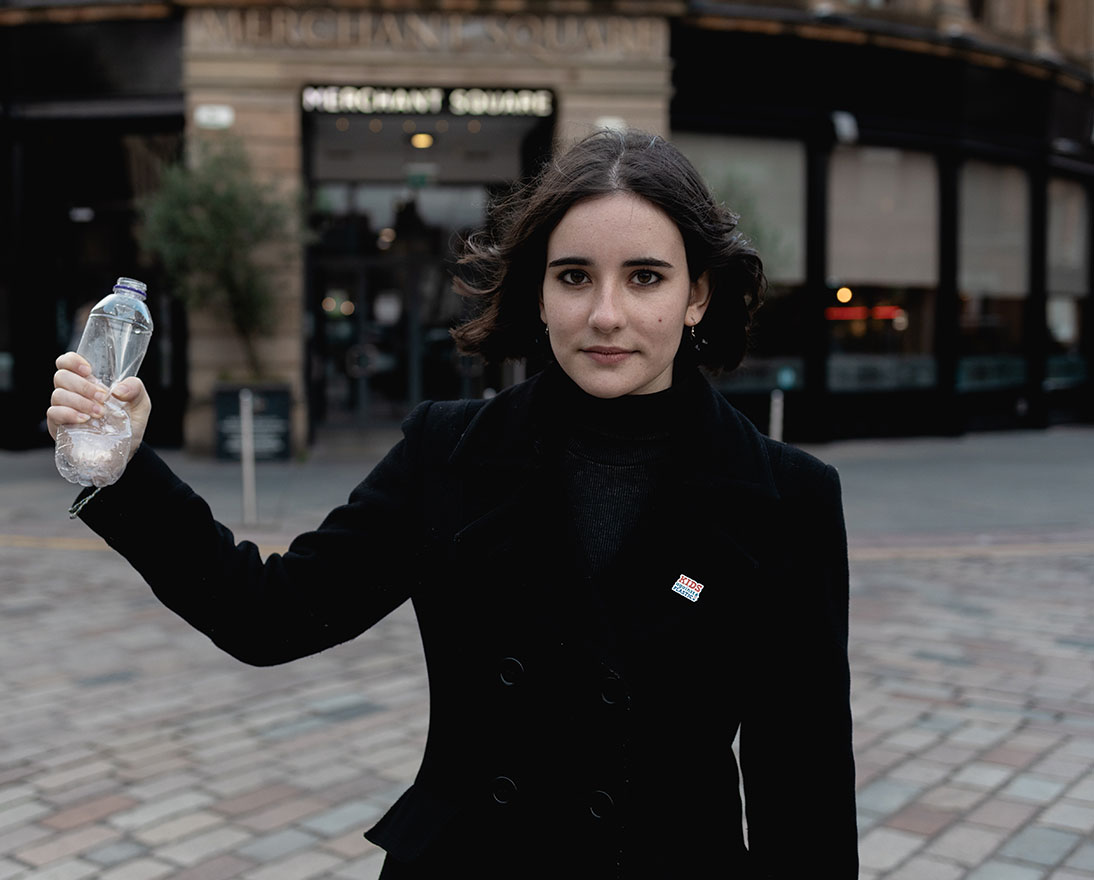Does this statue contain the secret to net-zero?
SustainabilityArticleDecember 10, 20216 min read
It’s concrete. But not as we know it.
During COP26, Zurich Insurance Group (Zurich) placed a statue in the city of Glasgow to inspire people to take action to combat climate change. Featuring six figures, it invites people to take their own pledge to help the planet.
But the statue does not just inspire and symbolise climate action, it also showcases new technologies that can help reduce carbon emissions and tackle global warming. And the secret is on the inside. It’s a technical story involving chemistry, the latest climate tech and new climate science – a story that could make a big difference on the journey to a net-zero world.
At first glance, the statue looks like a typical concrete structure, albeit beautifully sculpted. But concrete is highly carbon intensive. This concrete statue is not. It’s made with captured carbon.
Standard concrete is made from cement, water and aggregates, such as gravel, sand or crushed stone. The production of cement emits high levels of carbon dioxide (CO2) as it relies on a chemical reaction to turn limestone (CaCO3) into lime (CaO) – a process that also releases CO2. The aggregates, meanwhile, are normally dug out of the ground.
But the aggregates used to create this statue are different. They are not dug out of the ground. They are the world’s first artificially created carbon negative aggregates, the result of more than 20 years of painstaking research by UK-based carbon capture specialist O.C.O Technology.
It is the end result of a process that takes an industrial hazardous waste product, treats it and binds it with CO2 to create a new and sustainable product that captures an impressive 37kg of carbon for every tonne of artificial aggregate produced.
A world first for waste
It all starts with rubbish. In many countries, non-recyclable waste is sent to ‘energy recovery facilities,’ where it is incinerated and combusted into hot gas that is converted into energy. In the UK, this energy goes into the National Grid to heat homes and businesses.
During the incineration process, certain by-products are produced which need specialist treatment and disposal. Among these are combustion gases, which are cleaned by the injection of lime, and then collected as particulates in bag filters. The resulting fine powder ash is known as Air Pollution Control residues (APCr).
Steve Greig, Managing Director of O.C.O Technology, explains: “Because the APCr is a hazardous waste, it is usually sent to landfill or stored underground. O.C.O’s ground-breaking technology offers an alternative that not only safely treats the APCr, but turns it into a completely new product.”
O.C.O has developed and patented a process called Accelerated Carbonation Technology (ACT), which blends the ash with CO2 gas, stabilizing the contaminants and producing pellets of calcium carbonate. In other words, manufactured limestone or M-LS for short.
Because more CO2 is captured within the pellets than is emitted though the manufacturing process, the M-LS has been designated carbon negative. The UK Environment Agency has granted the M-LS ‘End of Waste’ (EoW) approval securing the aggregate’s position as an example of the circular economy in action.
Greig continues: “About 14 years ago, we came across a new, lab-based technology developed by academics at the University of Greenwich. They discovered that if you expose certain waste to carbon dioxide it goes hard. We worked with the university to see if we could develop this technology into an actual business.”
The answer was a very clear yes. To date, at its three UK manufacturing facilities, O.C.O has produced over one million tonnes of the aggregate – enough to build almost 10,000 three-bedroom houses.
It is becoming an increasingly popular ingredient within the construction industry for those seeking to build ‘greener’ buildings. The aggregate can be used in the manufacture of concrete and other construction materials such as blocks, bricks, pipe bedding and asphalt. And now, as we have learned, statues too.
Recycling industrial toxic residues into a safe product or raw material is a great innovation. But it is the carbon negative properties of the material that are attracting most attention due to the impact they can have on the future of the carbon capture industry.
Carbon capture
Carbon capture, utilization and storage, or CCUS, is an important group of emissions reduction technologies. They either capture CO2 from the source, such as power plants and industrial facilities, or they capture it directly from the atmosphere. In both cases, the captured CO2 is compressed and permanently stored by injecting it deep into sealed geological formations, including depleted oil and gas reservoirs.
O.C.O shows that this captured carbon does not have to be stored deep underground. Instead, it can have a commercial purpose that still ensures the carbon is stored permanently.
Up to now, O.C.O has used ‘pure’ CO2 purchased from industrial plants. This allows it to produce an aggregate with a carbon footprint of minus 37 kilograms of CO2 per tonne of aggregate.
But Technical Director at O.C.O Technology Stephen Roscoe explains they are developing technologies to enable the capture of CO2 directly from the flue and directly from the air. This will further reduce the carbon footprint of the aggregate.
The ‘direct from flue’ capture technology is being developed in trials in Japan, where CO2 is captured from combustion gases emitted from a chimney stack in an energy recovery facility. This CO2 is then blended with the APCr recovered from the same plant to create a carbon negative aggregate.
O.C.O is also working as part of a consortium formed by climate tech start-up Mission Zero Technologies, to accelerate the development of new ‘direct air capture’ technologies. “It removes COfrom the atmosphere through a solvent. You then heat the solvent, which releases concentrated CO2 that we can use in our process to create carbon negative aggregate,” explains Roscoe.
A net-zero future
Carbon capture is an emerging industry and is among a suite of potential technologies that will help the world achieve net-zero. “The ability to successfully capture carbon will be critical in the fight against climate change,” says Greig.
“Every year, we already capture more than 20,000 tonnes of CO2, and that figure is growing annually as we expand the business worldwide. Our patented technology allows us to go one step further too, not just capturing the carbon but utilizing it to transform waste CO2 into new and innovative products, such as the carbon negative aggregate used in Zurich’s statue – a project we were honored and thrilled to be part of.”
Throughout COP26 and online via an augmented reality filter, the statue has inspired people to take climate action. Through collective action, individual behaviors can have a strong impact on climate change. Similarly, the collective actions of innovative organizations like O.C.O Technology can help develop transformational solutions.



